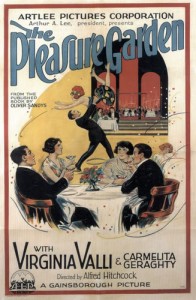Click here to print
Hitchcock’s Directorial Debut, Restored
posted June 29, 2012
 Alfred Hitchcock’s directorial debut, The Pleasure Garden, a silent melodrama made in 1925 when he was 25, follows the differing fortunes in love of two dancers at a London nightspot. Played by Universal star Virginia Valli and rarely again filmed Carmelita Geraghty, their fortunes take melodramatic, differing turns: One becomes a major star, while the other stumbles into a marriage with a dangerous womaniser, played by Miles Mander.
Alfred Hitchcock’s directorial debut, The Pleasure Garden, a silent melodrama made in 1925 when he was 25, follows the differing fortunes in love of two dancers at a London nightspot. Played by Universal star Virginia Valli and rarely again filmed Carmelita Geraghty, their fortunes take melodramatic, differing turns: One becomes a major star, while the other stumbles into a marriage with a dangerous womaniser, played by Miles Mander.
The British Film Institute’s restoration of the film, with a new score by Daniel Patrick Cohen, was unveiled at London’s Wilton’s Music Hall this week, and won the praise of the Guardian‘s Henry K. Miller: “It’s not just that 20-odd minutes have been added to the extant hour-long version; it’s that what we had didn’t entirely make sense without them. The most widely available version before now was pared down to the narrative bone, often at the expense of what became known as the Hitchcock touch.”
Miller describes what had been cut by the studio, Hitchcockian touches such as “comic business of various kinds, and a signature cut from a pot of tea being poured to a glass of champagne being filled.” In the restoration, he writes, “above all, the film has got its rhythm back.” A honeymoon sequence shot around Lake Como, for example, now “plays as Hitchcock inferably intended: longish, slowish, and sad, standing out from the rest. It is also in this section that the restored image comes into its own: almost unrecognisably cleaner, more detailed, pleasingly tinted and toned, and jerk-free.”
Until now, The Pleasure Garden has been available only in its truncated version, and in poor quality, on film and DVD. In The Independent, Holly Williams explained that the BFI is presenting the restoration as part of a month-long celebration of Hitchcock, and as the BFI’s contribution to arts offerings around London’s staging of the Olympic Games. Bryony Dixon, BFI’s silent film curator, told Williams. “And there’s only really one filmmaker who stands head and shoulders above everybody, and that’s Hitchcock. So it was a no brainer for us.”
Williams writes: “The BFI’s Olympian, Hitchcockian project has been a huge restoration of ‘The Hitchcock Nine’ – his first nine silent films. They raised a hefty £2million in order to complete four years of painstaking work, and the now the fruits of their labour go on display in a series of screenings with new scores from musical artists including Nitin Sawhney and Soweto Kinch.”
She describes, in detail, the BFI’s challenges and accomplishments in restoring The Pleasure Garden, in particular.
On its own website, the BFI has posted various materials about the film, including a copy of a letter about it that Hitchcock wrote home. Also there is an article by Mark Duguid, from BFI Screenonline. Hitchcock, he writes, was working with Michael Balcon’s fledgling Gainsborough Studios when the opportunity to direct came his way. Only 25, he had nonetheless already been assistant director on three films by the studio’s lead director, Graham Cutts, whom he had annoyed by ably demonstrating his abilities in several support roles.
Balcon sent Hitchcock to Germany to direct The Pleasure Garden, Eliot Stannard’s adaptation of a novel by Oliver Sandys. Stannard collaborated on all but one of Hitchcock’s silent films. And, wrote Duguid, “his script included many of the elements that would preoccupy the director over the next half-century, including the theatre, voyeurism, murder, and male violence against women. A striking opening features the chorus girls of the nightspot of the title descending a spiral staircase, with the camera fixed on their legs. We then observe them dancing, watched with evident glee by a largely male audience. One elderly man leers through opera glasses at his favourite girl, who is first flattered, then appalled, as she realises his attention is directed at her legs. This approach, forcing the audience to recognise its own voyeurism, was to become a distinguishing feature of Hitchcock’s work.”
With soon-characteristic bluster, Hitchcock announced his arrival as a director by including his handwritten signature in the titles. “Actors come and actors go,” Hitchcock told the Film Society in 1925, “but the name of the director should stay clearly in the mind of the audiences.”
Duguid notes that although Hitchcock completed The Pleasure Garden in 1925, the Gainsborough studio’s financier, C.M. Woolf, hated it so much that, despite very favourable advance reviews, he held up its release until 1927, as he did Hitchcock’s next two films The Mountain Eagle (1925) and The Lodger (1926).
Printed from Moving Image Archive News: https://www.movingimagearchivenews.org
URL to article: https://www.movingimagearchivenews.org/hitchcocks-directorial-debut-restored/
Click here to print